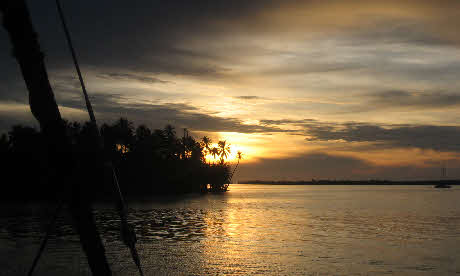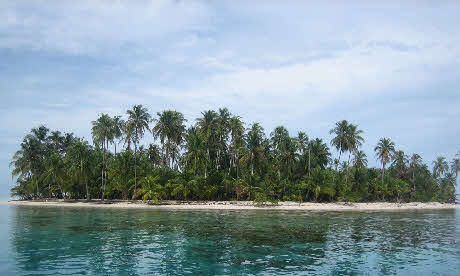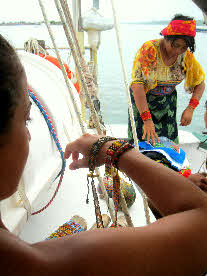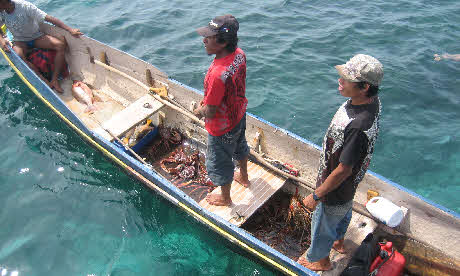



Why fly between Panama and Colombia when you could explore the islands and coral reefs of San Blas, says Thomas Rees
I woke just as the storm was breaking, as the first of the iron grey waves enveloped the prow. Veins of lightening ran through the bank of cloud ahead of us and it glowed, just for a second, blue-black like a bruise. Fritz stayed on deck as we stumbled to our cabins, wiping the salt-water from his thick-lensed glasses and barking instructions to the crew. A string of German swear-words followed me down the narrow stair-well as I descended into the belly of the catamaran, ducking low beneath the polished wood of the door frames and clambering into the narrow birth with it's sweet smell of paint and old varnish. I had left Central America behind, a hundred nautical miles in the distance, through the windswept night, lay the lights of Cartagena.
Unless you have a private army at your disposal or aspire to be the star of the continent's next hostage crisis, overland travel between Panama and Colombia would be unwise. The jungles and swamps of the Darién Gap are the stuff of legend, the stronghold of the last of the FARC rebels and a smoke screen for the nefarious activities of drug traffickers. But that doesn't mean you should fly. There's too much to see at the naval of Latin America. Far better to book a spot on one of the private yachts that ply their trade ferrying travellers between Panama and the Colombian coast.
After backpacking my way through Central America, I did just that, arranging my passage with Fritz, an eccentric Austrian businessman-turned-skipper sailing the route in his 50ft catamaran. Just a few months after my journey, Fritz entrusted his boat to a washed up captain with a fondness for rum rations and subsequently lost it to the waters of the Caribbean. But there are plenty of others still operating, sailed by reliable sorts with scrupulous safety records and reams of recommendations.
The yacht was moored at Carti, three hours from Panama City along patch-work roads of broken tarmac and bare earth. It was there that I boarded a motor launch in the fumbling light of dawn and arrived to find Fritz out on deck in Birkenstocks and sky-blue swimming trunks, making the final preparations. 'Alles ist gut!' he said with a smile.
We set sail that morning, bound for San Blas, a network of islands that surpass the most palm-fringed of holiday brochure cliches, and spent three days floating through the archipelago, snorkelling along reefs of fire coral and eating lobster from paper plates. Angle fish with feather-like fins glided through the shallows and, in the deeper water, barracuda stalked silvery shoals that scattered as they approached, like shards of softly broken glass.
The San Blas Islands are home to the Kuna, a nation of weather-beaten Amerindians who eke out an existence tending glades of coconut palms and trading with passing ships. Juan, the Panamanian deck hand pointed out the silhouettes of their fishing boats in the distance. "They're diving for shellfish," he said. "Some of them can hold their breath for ten minutes."
While Kuna men are famed for their aquatic prowess, the women of San Blas, or Kuna Yala as it is also known, pride themselves on their fabrics. At Nagaurchirdup, three women in orange headscarves paddled over in a canoe beneath the shade of a tattered parasol. "Mola sellers" said Juan, as they unloaded their baskets. Made from layers of cloth and decorated with geometric patterns and brightly coloured birds, mola form the central panels of Kuna blouses. The finest examples are highly prized and well worth a lazy afternoon of haggling.
As the sun set that evening, we headed for the open sea, leaving the shelter of the islands and braving the waiting storm. We kept watch in shifts until it passed. Alfred, the retired accountant, woke Toby the photographer, who woke the French couple, who woke me as the first of the Colombian lighthouses appeared: flecks of hot light in the mist.
By the time we arrived in Cartagena on the fifth day, I was glad to escape the claustrophobic cabins, the sleeping bags damp with sweat and salt water, and the lingering seasickness. But I'd do it again in a second.
Hauling our rucksacks from the harbour to the centre of town, we passed a group of tourists, their suitcases emblazoned with luggage tags and flight stickers. I didn't have the heart to tell them what they'd missed.
The logistics: Upwards of 20 yachts sail this route in both directions with most spending three days in the San Blas Islands and around 40 hours on the open ocean. You can book a cabin at hostels and hotels, both in Cartagena and Panama City. Hostel Mamallena provide a comprehensive list of boats, complete with departure times and further details. At the time of writing, the trip cost around $500. It's by no means a budget option but well worth the expense and infinitely preferable to spending $350 dollars on a 90-minute flight. Most boats provide snorkeling gear but it can be a little leaky so it's worth taking your own. Seasickness tablets are highly recommended, save them for the open sea when things can get a little choppy!